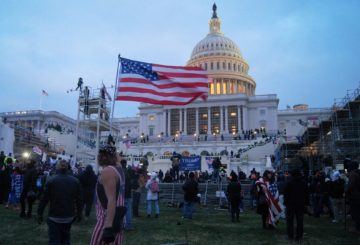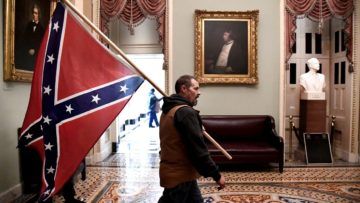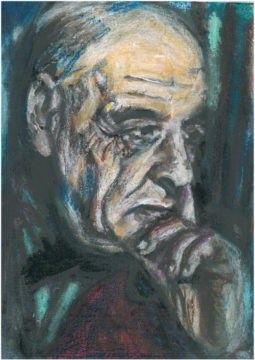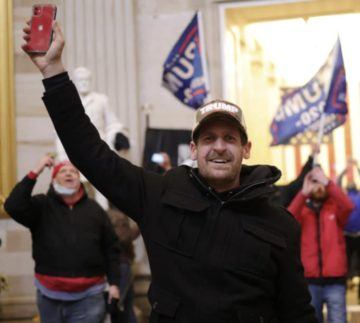Category: Recommended Reading
For Donald Trump, what began as farce is ending as tragedy
Marilynne Robinson in The Guardian:
 A kinder fate might have cast Donald J Trump as a maitre d’ in the world of swank, careful to save the best tables for his best customers, warmly responsive to a good tip, the ultimate outsider as insider, being and also impersonating a man whose fondest memory of youth is the first time he heard “I Did It My Way.” But fate was not kind. It made him a billionaire of sorts with a trick of putting his name on vodka bottles and casinos, of growing richer through bankruptcies and bad debt, of enthralling the tabloids. And yet, despite all this, Manhattan seems to have remained unimpressed. A tower almost as tall as he said it was, remarkable hair, and yet he was the baffled outsider trying to figure out what he was getting wrong. What began as farce is ending as tragedy.
A kinder fate might have cast Donald J Trump as a maitre d’ in the world of swank, careful to save the best tables for his best customers, warmly responsive to a good tip, the ultimate outsider as insider, being and also impersonating a man whose fondest memory of youth is the first time he heard “I Did It My Way.” But fate was not kind. It made him a billionaire of sorts with a trick of putting his name on vodka bottles and casinos, of growing richer through bankruptcies and bad debt, of enthralling the tabloids. And yet, despite all this, Manhattan seems to have remained unimpressed. A tower almost as tall as he said it was, remarkable hair, and yet he was the baffled outsider trying to figure out what he was getting wrong. What began as farce is ending as tragedy.
Fate truly outdid herself when she made him president of the United States. From this pinnacle of attainment he was able to look out over a vast world that was largely and unshakably certain he did not belong there. It would be easier to grant the pathos of his situation if his response to it had not been so largely bitterness and rage, and if his great office had not magnified his petulance into a force that could destabilize the republic.
The attack on the US Capitol, perhaps satisfying as revenge, was still a serious miscalculation. Trump told his mob once again that he had been cheated out of re-election, then sent them off to the Capitol where his defeat, an accomplished fact, was being formalized and finalized in deference to law and tradition, two sources of exasperation that had nagged him since he first set foot in the Oval Office. Which, by the way, is not all that spectacular.
More here.
Saturday, January 9, 2021
The Four-Year Assault
 Adam Shatz in the LRB:
Adam Shatz in the LRB:
So this is how it ends. Four years of rage and lies; four years of racism and xenophobia so coarse and inflammatory Richard Nixon might have blushed; four years of dismantling economic and environmental regulation, packaged as a populist revolution on behalf of the forgotten (white) American; four years of ‘law and order’ indistinguishable from moral and political disorder; four years of war against the media, ‘globalists’, ‘elites’ and other ‘enemies of the people’, which is to say his people, or rather his loyalists; four years of contempt for the vulnerable, whether Muslims, undocumented immigrants, Black victims of police brutality or those afflicted with Covid-19; four years of garish exhibitionism parading as leadership – four years of Donald Trump in power have led to the bizarre and grotesque spectacle of 6 January.
To call the explosion of the mob that took over the Capitol building an attempted coup, or an insurrection, is unfair to the plotters of coups and insurrections. Like the man who egged them on in a speech that morning – and who had spent the last two months refusing to concede the election, going so far as to order Georgia’s secretary of state to ‘find’ votes to overturn the outcome – the revellers in DC were practitioners of what political scientists call ‘expressive’ politics, capable only of defiant stonewalling and destructiveness. Some had arrived in full Civil War re-enactment regalia, carrying rifles and Confederate flags. Others looked as if they were auditioning for a sequel to The Big Lebowski, notably the ‘QAnon shaman’, Jake Angeli, a tattooed, shirtless man who strutted through the chambers of the Capitol with horns on his head and red, white and blue paint on his face. And then there were the neo-Nazis, white supremacists and militia members, the ‘fine people’ of Charlottesville. For all their shouts of ‘USA, USA,’ they represented a furious, desperate, lumpen minority unwilling, or unable, to accept defeat – or the ‘surrender’ of Trump’s Republican collaborators, who could no longer go on pretending that Joe Biden hadn’t won, especially when they realised the potential political costs of doing so.
More here.
It’s Time to Use Eminent Domain on the Coronavirus Vaccines

Arnab Acharya and Sanjay Reddy in Foreign Policy:
Jonas Salk, the scientist who developed the first effective polio vaccine, when asked “Who owns this patent?”, replied, “Well, the people, I would say. There is no patent. Could you patent the sun?” In a world where private companies reap the fruits of developing vaccines, many now view this attitude as quaint. But quite apart from the philosophical case, there are compelling practical reasons to adopt Salk’s attitude, and treat all vaccine formulas that have proved effective against COVID-19, like the sun, as a global public good.
The easiest way to make vaccines truly available to all is to freely license every effective vaccine formula so that generic producers can manufacture the vaccine anywhere. This approach would overcome the short-run limits on production, which come from intellectual-property restrictions that constrain production to specific firms. Doing away with this barrier would ensure that the vaccines are produced and sold by many actors in a competitive marketplace, and made available to the public at the least cost.
More here.
Criticism and Truth
 Jonathan Kramnick in Critical Inquiry:
Jonathan Kramnick in Critical Inquiry:
Does literary criticism tell truths about the world? This is a question scholars of literature don’t often ask, or don’t often ask directly, but it gets to the heart of how work in the discipline is done and why the discipline exists in the first place. One way to answer the question is to examine whether criticism attempts to make true statements about literary texts and, if so, by what means its statements are judged as true or false. How do we encounter and interact with our objects of study? Where does our writing begin and the writing we’re writing about end? How are consensus judgments about the validity or perspicuity or elegance of a reading made? Another way to come at this question is to examine whether criticism is capable in some fashion of telling truths about the world itself, not just the small piece of it called literature. Does criticism about ecology or consciousness, to take examples from my own work (and feel free to insert your own), tell some truth about ecology or consciousness themselves? I think we’d all like to believe that it does, but how? Both lines of inquiry take aim at method and therefore at epistemology. They ask how critical practice—writing about writing—purports to convey knowledge, whether that is knowledge about literature or knowledge about the world in which literature is one part. This essay is a preliminary effort to consider these two sides of the relation between criticism and truth.
More here.
The Campus Underground Press
 Liza Featherstone in JSTOR Daily:
Liza Featherstone in JSTOR Daily:
Famous for its social movements—against the Vietnam War, in defense of the planet, demanding Black civil rights, gay liberation, and women’s equality—the 1960s and 1970s were also a fertile time for the underground press in the United States. Reveal Digital’s Campus Underground collection on JSTOR includes more than seventy-five publications, many from college campuses or college towns (often produced by a loose cluster of students and other college-aged young people). The open access digital archive provides an exhilarating glimpse into this creative and politically incendiary period.
The explosion of small publications alongside the political upheaval—the latter of which is documented in a companion collection, Student Activism—is not a coincidence. Historically, an alternative press has thrived when social movements are most active. Political organizing gives the alternative press more material to write about. The movements also produce more readers for such outlets: in politically charged times, more people are open to new ideas and question established news sources.
More here.
Riot on the Hill
 Mike Davis in the NLR’s Sidecar:
Mike Davis in the NLR’s Sidecar:
Yesterday’s ‘sacrileges’ in our temple of democracy – oh, poor defiled city on the hill, etc. – constituted an ‘insurrection’ only in the sense of dark comedy. What was essentially a big biker gang dressed as circus performers and war-surplus barbarians – including the guy with a painted face posing as horned bison in a fur coat – stormed the ultimate country club, squatted on Pence’s throne, chased Senators into the sewers, casually picked their noses and rifled files and, above all, shot endless selfies to send to the dudes back home. Otherwise they didn’t have a clue. (The aesthetic was pure Buñuel and Dali: ‘Our only rule was very simple: no idea or image that might lend itself to a rational explanation of any kind would be accepted.’)
But something unexpectedly profound happened: a deus ex machina that lifted the curse of Trump from the careers of conservative war hawks and right-wing young lions, whose ambitions until yesterday had been fettered by the presidential cult. Today was the signal for a long-awaited prison break. The word ‘surreal’ has been thrown around a lot, but it accurately characterizes last night’s bipartisan orgy, with half of the Senate election-denialists channeling Biden’s call for a ‘return to decency’ and vomiting up vast amounts of noxious piety.
More here.
Patricia Highsmith | American Author | 1978
Patricia Highsmith at 100
Carmen Maria Machado at The Guardian:
 There has always been something fundamentally difficult about Patricia Highsmith. And not difficult in the way that most people mean it: ironic, quirky, feminist (“Well-behaved women rarely make history”, and so on). I mean truly, legitimately difficult; a well of darkness with no discernible bottom.
There has always been something fundamentally difficult about Patricia Highsmith. And not difficult in the way that most people mean it: ironic, quirky, feminist (“Well-behaved women rarely make history”, and so on). I mean truly, legitimately difficult; a well of darkness with no discernible bottom.
Which is not to say that she wasn’t, in her own way, endearing. She was, after all, a genius, a bona fide eccentric. She loved animals, particularly snails, which she kept by the hundred as pets and took to parties clinging to a leaf of lettuce in her handbag. Writer and critic Terry Castle describes how she once “smuggled her cherished pet snails through French customs by hiding six or eight of them under each bosom”. She was famous for her wit and wicked sense of humour, and she wrote compellingly of loneliness and empathetically about disempowered housewives and children.
more here.
Shipwrecked at the Edge of the World
Rachel Slade at the NYT:
 Stories of Arctic expeditions continue to fascinate us because they expose humanity in extremis — people pushed to their best and worst by hypothermia, hunger and despair. Sir John Franklin’s 1845 Arctic expedition to find a northwest passage became the shame of Britain when it was discovered that his men, trapped for months in Canada, resorted to cannibalism. Ernest Shackleton is a hero for rescuing all but three of his crew in Antarctica after his ship, the Endurance, was lost.
Stories of Arctic expeditions continue to fascinate us because they expose humanity in extremis — people pushed to their best and worst by hypothermia, hunger and despair. Sir John Franklin’s 1845 Arctic expedition to find a northwest passage became the shame of Britain when it was discovered that his men, trapped for months in Canada, resorted to cannibalism. Ernest Shackleton is a hero for rescuing all but three of his crew in Antarctica after his ship, the Endurance, was lost.
The challenges Barents faced are similarly elemental. Tacking against an Arctic wind between towering icebergs while feeling one’s way through uncharted waters is a profoundly nerve-racking task, and Barents’s men did it day and night for weeks on end, fighting fatigue, scurvy, boredom and loneliness. The 11 months they spent huddled in the dark in a windowless makeshift cabin, slowly starving to death, makes quarantining during the pandemic seem like an endless spa day.
more here.
Saturday Poem
Slash & Burn
Fir trees shake their skirts, free
their perfume of sharp summer musk. So much
is certain: the dry rasp of wildfire plumes,
the cicadas climbing from their grave
after seventeen years of dust, a harvest
of long, green tongues in late June, the slow
descent of gasoline prices. I can hardly breath
in this biome, neither desert nor alpine
but scabbed prairie full of snake holes and basalt
pillars, which crumble and clink like glass under flat
feet. From here, each trunk in the low
bowl blazes red behind sunken city light. Yesterday
I saw six pallbearers carry that smooth
onyx box. I saw a girl garbed in a shiny, yellow
slicker laugh at her reflection. I saw over-wintered
bulbs dug up like small fists. The trees;
the huge lungs which satiate sky and still
kill all flora beneath their cradle of long limbs. This
is a great and savage secret: the slow ooze of amber sap,
the sweet, acidic bed of needles, the fingers
of demigods soaking up what they will. You must overturn
the spilled cup. You must squander nothing.
by Kaitlyn Airy
from the Echotheo Review
Chaos and Carnage
Rafia Zakaria in The Baffler:
 At noon, one hour before the two chambers met in joint session, President Trump took the stage before a crowd not far from 1600 Pennsylvania Avenue. There he whipped up the faithful, men and women he had fed and fattened with stories of election fraud and voting dumps, to march on the Capitol and protest outside. The crowd cheered him on, considering themselves to be real (and armed) patriots there to save America at the “Save America rally.”
At noon, one hour before the two chambers met in joint session, President Trump took the stage before a crowd not far from 1600 Pennsylvania Avenue. There he whipped up the faithful, men and women he had fed and fattened with stories of election fraud and voting dumps, to march on the Capitol and protest outside. The crowd cheered him on, considering themselves to be real (and armed) patriots there to save America at the “Save America rally.”
Everyone knows what happened next. Even as cable news switched between the House and the Senate, which had returned to their respective chambers to debate the objections to Arizona’s electoral votes, the crowd outside the Capitol grew and became ever more strident. As the objectors to the electoral vote count began to speak of feigned irregularities, the pulsating crowd laid siege to the Capitol. Then it was up the steps, and ultimately it stormed its way in. Photographs showed Confederate flag-bearing protesters in Statuary Hall, others standing in the Senate Chamber. Who could say whether some were carrying weapons? A photo later showed a man carrying plastic handcuffs, as if he hoped to take hostages.
It was eight o’clock in the evening—two hours after a 6 p.m. curfew came into effect on the streets of D.C. and after law enforcement had “retaken” the Capitol building—when the lawmakers met again. The people were the same, but the political calculations had unalterably changed. Sticking with a post-loss Trump, a move glibly rebranded by Senator Ted Cruz as “[protecting] the integrity of our democratic system,” now bore a greater political cost. Many Americans may have passively supported Trump’s efforts to own the libs and even to complain about fraud; few would be able to applaud the sight of armed protesters storming the Capitol, forcing lawmakers into lockdown and prompting foreign government officials to offer up best wishes for a return to order.
Arguably, it was the only way Trumpism could have been dealt a death blow.
More here.
The Whole Story in a Single Photo
Clint Smith in The Atlantic:
 On Wednesday afternoon, as insurrectionists assaulted the Capitol, a man wearing a brown vest over a black sweatshirt walked through the halls of Congress with the Confederate battle flag hanging over his shoulder. One widely circulated photo, taken by Mike Theiler of Reuters, captured him mid-stride, part of the flag almost glowing with the light coming from the hallway to his left.
On Wednesday afternoon, as insurrectionists assaulted the Capitol, a man wearing a brown vest over a black sweatshirt walked through the halls of Congress with the Confederate battle flag hanging over his shoulder. One widely circulated photo, taken by Mike Theiler of Reuters, captured him mid-stride, part of the flag almost glowing with the light coming from the hallway to his left.
The fact that this photo was taken the day after voters in Georgia chose the first Black person and the first Jewish person in the history of that state to serve in the Senate; that it shows a man walking past the portrait of a vice president who urged the country to sustain human bondage and another portrait of a senator who was nearly beaten to death for standing up to the slavocracy; that it portrays a man walking with a Confederate flag while a mob of insurrectionists pushed past police, broke windows, vandalized offices, stole property, and strolled through the halls of Congress for hours, forcing senators and representatives into hiding and stopping the certification of the electoral process—it is almost difficult to believe that so much of our history, and our current moment, was reflected in a single photograph. This photo seemed to capture the divide between who we purport to be and who we have actually been, the gap between our founding promises and our current reality.
The flag the man carried, which we have all come to associate with the Confederacy, was not the first that flew over the Confederate States of America. In 1861, following the election of Abraham Lincoln, southern states began seceding from the Union in order to perpetuate the institution of human bondage. As Mississippi said during its secession convention, “Our position is thoroughly identified with the institution of slavery—the greatest material interest of the world.”
More here.
Friday, January 8, 2021
The Aesthetic of Evil
On José Ortega y Gasset
Morgan Sloan at Philosophy Now:
 The impact of Germany on Ortega’s thoughts about his own country can be seen in his first major publication, Meditations on Quixote (1914), a book which, far from merely being a commentary on the famous Spanish novel, serves as a summary of Orteguian thought. Influenced by the biologist Jacob Von Uekull’s idea that a living organism must be studied within its environment in order to be understood, Ortega argued that human life must also be understood through its circumstances: “Circumstantial reality makes up the other half of me as a person: I need it to imagine myself and to be my true self,” he wrote. Social status, historical period, nationality, geographic location, and economic situation are all relevant when it comes to understanding how one sees the world and oneself, since they determine our perspective. This idea is summarized in Ortega’s most famous quote: ‘‘I am I and my circumstance, and if I do not save it, I do not save myself.’’ In just the same way that Ortega ventures out into the world down the Guadarrama river near his hometown, or that the Ancient Egyptians would have ventured out down the Nile, we also venture out into the world from our own places of origin. Regardless of how many new ideas you may open yourself to, and no matter how much they change your way of thinking, it will always be you perceiving them; your past experiences, your childhood, your economic and social status, your nationality, your historical period are vital in defining you as a person.
The impact of Germany on Ortega’s thoughts about his own country can be seen in his first major publication, Meditations on Quixote (1914), a book which, far from merely being a commentary on the famous Spanish novel, serves as a summary of Orteguian thought. Influenced by the biologist Jacob Von Uekull’s idea that a living organism must be studied within its environment in order to be understood, Ortega argued that human life must also be understood through its circumstances: “Circumstantial reality makes up the other half of me as a person: I need it to imagine myself and to be my true self,” he wrote. Social status, historical period, nationality, geographic location, and economic situation are all relevant when it comes to understanding how one sees the world and oneself, since they determine our perspective. This idea is summarized in Ortega’s most famous quote: ‘‘I am I and my circumstance, and if I do not save it, I do not save myself.’’ In just the same way that Ortega ventures out into the world down the Guadarrama river near his hometown, or that the Ancient Egyptians would have ventured out down the Nile, we also venture out into the world from our own places of origin. Regardless of how many new ideas you may open yourself to, and no matter how much they change your way of thinking, it will always be you perceiving them; your past experiences, your childhood, your economic and social status, your nationality, your historical period are vital in defining you as a person.
more here.
The Black Romantic
Jasmine Sanders at Artforum:
 Their oeuvre comprises two categories, into which the bulk of Black Romantic art can also be slotted: “Home and Family Life” and “Religious and Spiritual Paintings.” The former is all nuclear bliss and filial piety—Mommy and Daddy dole out kisses and baths and lead the children in bedtime prayers. Little black girls come draped in the oversize uniforms of secretaries and teachers, the boys outfitted as preachers, lawyers, and athletes, all smiling a bit too wide and glowing the same glazed-honey-bun brown. The aforementioned Daniel belongs to the latter grouping, alongside other familiar biblical tableaux, the figures all recast as black and rendered with expressive detail. Christ, pressed hair agleam beneath the halo, shepherds his flock through thick Edenic brush. A personal favorite is Visitation, 1998, in which a white-robed girl gazes heavenward, the sky behind her a froth of crepuscular blues, greens, and plums. Her exposed neck imparts a devilish stroke of carnality welcome amid the otherwise pious scene. Likewise her glossed lips, which, along with her wispy bangs, situate her firmly in modernity, a Madonna-cum–round-the-way girl. Before her are lilies of all varieties and in all stages of bloom, their sharp, distinct oil lines contrasting with the gauzy, airbrushed sky. Smaller, yellow buds blossom throughout, a tonal invocation of the orisha Oshun, lover of honey, sensuality, and mayhem. The infusion of paganism and possibly Yoruba symbolism unyokes the portrait from its stodgy biblical origins and releases it into more rousing territory. Are we witnessing a visitation or a conjuring? Is hers the white robe of the Pentecost or the Priestess?
Their oeuvre comprises two categories, into which the bulk of Black Romantic art can also be slotted: “Home and Family Life” and “Religious and Spiritual Paintings.” The former is all nuclear bliss and filial piety—Mommy and Daddy dole out kisses and baths and lead the children in bedtime prayers. Little black girls come draped in the oversize uniforms of secretaries and teachers, the boys outfitted as preachers, lawyers, and athletes, all smiling a bit too wide and glowing the same glazed-honey-bun brown. The aforementioned Daniel belongs to the latter grouping, alongside other familiar biblical tableaux, the figures all recast as black and rendered with expressive detail. Christ, pressed hair agleam beneath the halo, shepherds his flock through thick Edenic brush. A personal favorite is Visitation, 1998, in which a white-robed girl gazes heavenward, the sky behind her a froth of crepuscular blues, greens, and plums. Her exposed neck imparts a devilish stroke of carnality welcome amid the otherwise pious scene. Likewise her glossed lips, which, along with her wispy bangs, situate her firmly in modernity, a Madonna-cum–round-the-way girl. Before her are lilies of all varieties and in all stages of bloom, their sharp, distinct oil lines contrasting with the gauzy, airbrushed sky. Smaller, yellow buds blossom throughout, a tonal invocation of the orisha Oshun, lover of honey, sensuality, and mayhem. The infusion of paganism and possibly Yoruba symbolism unyokes the portrait from its stodgy biblical origins and releases it into more rousing territory. Are we witnessing a visitation or a conjuring? Is hers the white robe of the Pentecost or the Priestess?
more here.
Just Hierarchy: Why Social Hierarchies Matter in China and the Rest of the World
Leanne Ogasawara in The New Rambler:
 Imagine a drowning city. The collapse of the Greenland ice sheets has led to a ten-foot rise in global sea-levels. You think this is bad, but it is followed by further melting at the Aurora Basin in East Antarctica, resulting in another forty-foot rise. In his novel, New York 2140, Kim Stanley Robinson paints a picture of a flooded Manhattan, where morning commuters use vaporetti to travel to and from work and live in apartment towers that reach up out of the rising waters into the sky. As you might imagine, the city suffers from staggering income inequality. Hedge-fund millionaires weave in and out of shipping lanes in their private speedboats, as kids who can’t read ferry people around in leaky gondolas through waters poisoned with toxic waste. The world is facing an unprecedented existential threat. And survival will demand collective action and sacrifice. In such a world, what kind of government would you want calling the shots?
Imagine a drowning city. The collapse of the Greenland ice sheets has led to a ten-foot rise in global sea-levels. You think this is bad, but it is followed by further melting at the Aurora Basin in East Antarctica, resulting in another forty-foot rise. In his novel, New York 2140, Kim Stanley Robinson paints a picture of a flooded Manhattan, where morning commuters use vaporetti to travel to and from work and live in apartment towers that reach up out of the rising waters into the sky. As you might imagine, the city suffers from staggering income inequality. Hedge-fund millionaires weave in and out of shipping lanes in their private speedboats, as kids who can’t read ferry people around in leaky gondolas through waters poisoned with toxic waste. The world is facing an unprecedented existential threat. And survival will demand collective action and sacrifice. In such a world, what kind of government would you want calling the shots?
This question is not something only out of the world of fiction. Climate change and a worldwide pandemic are on everyone’s mind. Yet, for all the talk, it could be argued that intellectuals are not discussing enough what types of government might be best suited for making the tough decisions necessary for long-term planning and collective preparation. One notable exception to this is political philosopher Daniel Bell, who for the last two decades, has been writing books and a seemingly endless stream of provocative op-ed pieces highlighting the ways in which less-democratic forms of government might be better suited to tackling the tough issues we now face.
More here.
Medicine’s Machine Learning Problem
Rachel Thomas in the Boston Review:
 Data science is remaking countless aspects of society, and medicine is no exception. The range of potential applications is already large and only growing by the day. Machine learning is now being used to determine which patients are at high risk of disease and need greater support (sometimes with racial bias), to discover which molecules may lead to promising new drugs, to search for cancer in X-rays (sometimes with gender bias), and to classify tissue on pathology slides. Last year MIT researchers trained an algorithm that was more accurate at predicting the presence of cancer within five years of a mammogram than techniques typically used in clinics, and a 2018 survey found that 84 percent of radiology clinics in the United States are using or plan to use machine learning software. The sense of excitement has been captured in popular books such as Eric Topol’s Deep Medicine: How Artificial Intelligence Can Make Healthcare Human Again (2019). But despite the promise of these data-based innovations, proponents often overlook the special risks of datafying medicine in the age of artificial intelligence.
Data science is remaking countless aspects of society, and medicine is no exception. The range of potential applications is already large and only growing by the day. Machine learning is now being used to determine which patients are at high risk of disease and need greater support (sometimes with racial bias), to discover which molecules may lead to promising new drugs, to search for cancer in X-rays (sometimes with gender bias), and to classify tissue on pathology slides. Last year MIT researchers trained an algorithm that was more accurate at predicting the presence of cancer within five years of a mammogram than techniques typically used in clinics, and a 2018 survey found that 84 percent of radiology clinics in the United States are using or plan to use machine learning software. The sense of excitement has been captured in popular books such as Eric Topol’s Deep Medicine: How Artificial Intelligence Can Make Healthcare Human Again (2019). But despite the promise of these data-based innovations, proponents often overlook the special risks of datafying medicine in the age of artificial intelligence.
Consider one striking example that has unfolded during the pandemic.
More here.
Michael Sandel, Grace Blakeley, Rory Stewart debate the case for ideological politics
Decades of research on risk perception can help us understand the Trump supporters who stormed the Capitol
Catherine Buni & Soraya Chemaly in Undark:
 Although it is certainly true that Trump maintains a significant following among White women, his most fervent supporters tend to be White and male. Distributed across a wide swath of socioeconomic status, these men have unwaveringly — and even violently — supported the president, despite the historic risks his administration poses to public health, safety, and American democratic structures and ideals. No shortage of pundits and prognosticators have speculated about the factors underlying this support: Racism? The economy? Fragile masculinity? Class anxiety? Political fear? Sectarianism? In a New York Times op-ed last October, Michael Sokolove suggested that the political gulf between White men and just about everyone else should be dubbed “the White male gap” or “the White male problem.”
Although it is certainly true that Trump maintains a significant following among White women, his most fervent supporters tend to be White and male. Distributed across a wide swath of socioeconomic status, these men have unwaveringly — and even violently — supported the president, despite the historic risks his administration poses to public health, safety, and American democratic structures and ideals. No shortage of pundits and prognosticators have speculated about the factors underlying this support: Racism? The economy? Fragile masculinity? Class anxiety? Political fear? Sectarianism? In a New York Times op-ed last October, Michael Sokolove suggested that the political gulf between White men and just about everyone else should be dubbed “the White male gap” or “the White male problem.”
But cognitive scientists long ago coined a term for the psychological forces that have given rise to the gendered and racialized political divide that we’re seeing today. That research, and decades of subsequent scholarly work, suggest that if you want to understand the Trump phenomenon, you’d do well to first understand the science of risk perception.
More here.
